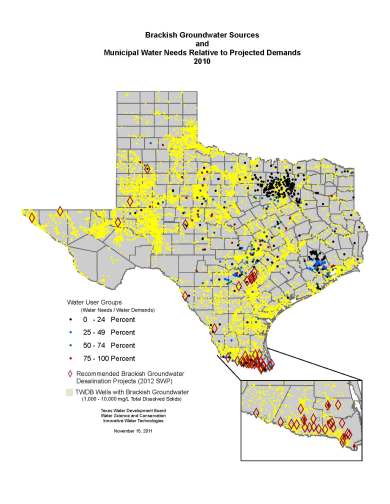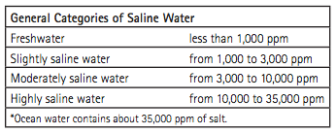Future Problem: growing water demands of Texas
As we all know, Texas is a rapidly growing state. The population is expected to increase by 82% in the next fifty years, doubling its population from 25.4 million to 46.3 million people. The Texas State Water plan predicts that the water demand will increase by 22%. Although this increase is not as enormous as the population growth (due to the decline in irrigation water demand and increased attention towards water conservation practices), it is still a colossal challenge for Texas water planners to figure how to allocate demand amongst all of its water-hungry sectors, including but not limited to irrigation, municipal, manufacturing, and mining needs. Additionally, the US has been plagued with a number of severe droughts, which further contribute to the stress on water managers planning for worst-case scenarios. It has become extremely important for Texas to re-evaluate its water supply and implement new water management strategies to meet these increasing demands.
Potential solution: desalination of brackish groundwater
One potential management strategy is the desalination of brackish groundwater, which is included in the current Texas Water Plan as a contributor to about 11% of the recommended strategies in place for 2060. Texas has a plentiful supply of groundwater, housing approximately 2.7 billion acre-feet of water volume below its soil surface. Previously, when freshwater supplies were abundant, brackish groundwater was nothing more than a futuristic, prospective resource. Today it has become one of the most important players in the global water conversation on meeting present and future water needs.
What exactly is brackish groundwater?
Brackish water is defined as water that is “distastefully salty” but significantly less salty than seawater. Brackish water can be found in surface water settings such as estuaries or ground water settings such as aquifers. The chart below displays the salt content for freshwater, brackish, and saline water.
Desalination is the process of removing these salts and dissolved solids from the brackish, saline, or seawater. Desalination is necessary if brackish groundwater is to be treated for municipal potable water use.
Drawbacks
Although there is an abundance of brackish groundwater, there are only 46 municipal desalination facilities in Texas, and only five regional water planning regions have recommended brackish groundwater desalination as a potential water source in the 2012 Texas Water Plan. Desalination has not always been popular because of it is energy-intensive and expensive infrastructure costs. At current economics, it is much more expensive to treatment brackish groundwater than freshwater. The capital costs of a desalination facility is particularly high, and the energy required for the thermal distillation process contributes to its energy intensity. Desalinated water cost is a function of its infrastructure capital, operating & maintenance, and technology costs. Furthermore, desalination produces a solid salt concentrate, which much be properly disposed of. Disposal methods include surface water or sewer discharge, deep well injection, or evaporation ponds, and are an additional cost to the overall process. Desalinated brackish water can cost up to $3 or $4 per 1,000 gallons.
The future is in desalination

Figure 2. The mechanisms of reverse osmosis
Despite these drawbacks, the use of desalinated groundwater will undoubtedly grow in the future. The state water plan predicts desalination will provide over 300,000 acre-feet of new water by 2060. Our freshwater supplies are being stressed and slowly depleted. We will eventually reach a point where the cost of desalination catches up to the cost of freshwater, and at that point, diversification of our water supply mix will be inevitable. Additionally, the technology for brackish desalination is evolving. The newest desalinate technology, reverse osmosis, utilizes membrane processes and pressure to separate the salts from the water. This technology requires one-fourth of the energy and costs half of the price as thermal distillation of saltwater.
Thus, the price difference to treat freshwater and brackish groundwater will undoubtedly converge, especially if Texas continues to experience intense droughts due to climate change. As our freshwater reserves become more stressed, the demand for freshwater will drive the prices up, making desalination more attractive. Desalination of brackish groundwater is slowly but surely becoming a more competitive and practical alternative for meeting water demands in Texas.






You must be logged in to post a comment.